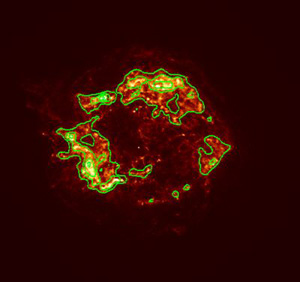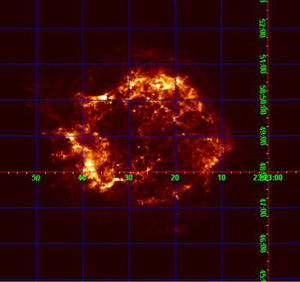 |  | |||||
| Learning ds9: Overview | Part 1 | Part 2 | Part 3 | [Contact Help] [Chandra Public Page] |
| |||||||||
| |||||||||
Learning to Use the ds9 Imaging SystemPart 2: More Features for Qualitative AnalysisDisplay contoursIso-intensity contours are connected lines drawn on the image through pixels of equal value. (The root "iso" comes from the Greek meaning "equal". We are talking here about marking out lines of equal pixel intensity on an image, just as a topographical map marks out lines of equal elevation.) These are useful for indicating large-scale features of an image. The analysis menu has an option to overlay iso-intensity contours on the image. You can choose the number of contours to generate, as well as the smoothness of the contour lines. If you select the display contours option first, it will display whatever setting has been left on the contours parameters menu. To chose the contour parameters click on that line and the menu will appear. Change the values as you wish and push both the generate and apply buttons, in that order, and wait for the new contour parameters to be drawn on the image. Your display of contour parameters may differ from what is displayed here. Change the contour parameters and see what happens. 
To remove contours, deselect the "Display contours" option on the analysis menu. Display coordinate grid Pull down the analysis menu and click on display coordinate grid menu option. A grid of astronomical sky coordinates will be displayed over the image. This is useful for reminding yourself where in the sky your object is located. This feature is especially useful when looking at areas of the sky with multiple sources, like the deep surveys, or areas where it is important to be able to pick out a particular source in an area where sources are close together. 
Summary There are, of course, other features in ds9 that will help you get a "qualitative" feel for your X-ray data so that you can begin to notice interesting features that you will want to analyze quantitatively. Don't be afraid to try things out! A detailed manual of ds9 features is on-line at the ds9 homepage. Next: Part 3: Learning ds9, Starting Quantitative Analysis Last updated: 08/26/08 |
|
Chandra Ed. Home Page | Installation | Learning ds9 | Activities & Images | Evaluation Learning ds9: Overview | part 1 | part 2 | part 3 Resources: ds9 | Chanda Public Information & Education |
|
|
Harvard-Smithsonian Center for Astrophysics 60 Garden Street, Cambridge, MA 02138 USA Phone: 617.496.7941 Fax: 617.495.7356 |
Comments & Questions? cxcedu@cfa.harvard.edu |
|
This site was developed with funding from NASA under Contract NAS8-39073. | |